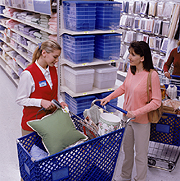Think of all the steps and travel your food went through to get to the dinner table. From the grower to the grocery store, multiple distributers and handlers serve a role in the food supply chain. However, the longer the supply chain in both time and transit, the more the opportunity for contaminants and bacteria to infect your favorite cuisine. So, who’s watching out for you? What can food growers and distributors do to help protect the food supply?
Ultimately, the FDA provides oversight and regulates the food supply. The FDA’s 2007 Food Protection Plan targets three food safety initiatives:
- Prevention – Promoting increased corporate responsibility so that food problems do not occur in the first place
- Intervention – Risk-based inspections, sampling, and surveillance at high risk points
- Response – Communicate clearly with consumers and other stakeholders during and after food emergencies
Unfortunately, the FDA’s biggest weakness lies in its prevention efforts, and that’s where the foodservice industry can make a huge impact. How? The answer is simple. Supply chain visibility—from the grower to the grocery store—using RFID and barcode technology. Moving RFID and bar code labeling and scanning deeper into food growers, shipping, and packaging chains enables easier tracing throughout the product lifecycle.
Full food supply chain visibility provides an extra layer of protection should a food borne illness occur, allowing growers and distributors to determine if the contamination occurred at the grower or was introduced within the distribution process, and who might else might also be affected. Traceability technology provides significant benefits to food safety. GS1 DataBar bar codes can store serial numbers, lot numbers, and expiration dates for fresh and manufactured food products. RFID tags provide read-write information that offers deep traceability—even if the RFID tag lies buried under bushels of tomatoes.
Consider the following locations for adding traceability:
- Farms and growers – According to the Produce Traceability Initiative (PTI), grower-packer-shippers of fresh produce must label each case of product they pack
- Receiving/shipping docks – Foodservice distributors can install RFID tags or bar code labeling equipment to mark incoming materials not already labeled, or scan/update the RFID tags and bar code labels to record or encode information.
- Lot control – Lot numbers can be encoded into bar codes or RFID tags and applied to pallet-, case-, inner pack-, or item-level packaging.
From a business and efficiency perspective, implementing traceability technologies also improves overall supply chain efficiency by delivering better inventory control, faster processing, and faster turn rate on items that have tight freshness windows.
For more details about GS1 bar code labeling and RFID tagging, see www.gs1.com and www.epcglobalinc.org.
 If the retailers where those people shop had used mobile point-of-sale queue-busting solutions, they would have seen more satisfied customers. Mobile printers can capture card information, communicate it for authorization, and create sales receipts. Stores can combine these capabilities with mobile computing systems to service customers throughout their facility, prevent long checkout lines or queues from forming, and create other services that improve customer convenience and satisfaction.
If the retailers where those people shop had used mobile point-of-sale queue-busting solutions, they would have seen more satisfied customers. Mobile printers can capture card information, communicate it for authorization, and create sales receipts. Stores can combine these capabilities with mobile computing systems to service customers throughout their facility, prevent long checkout lines or queues from forming, and create other services that improve customer convenience and satisfaction.




